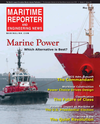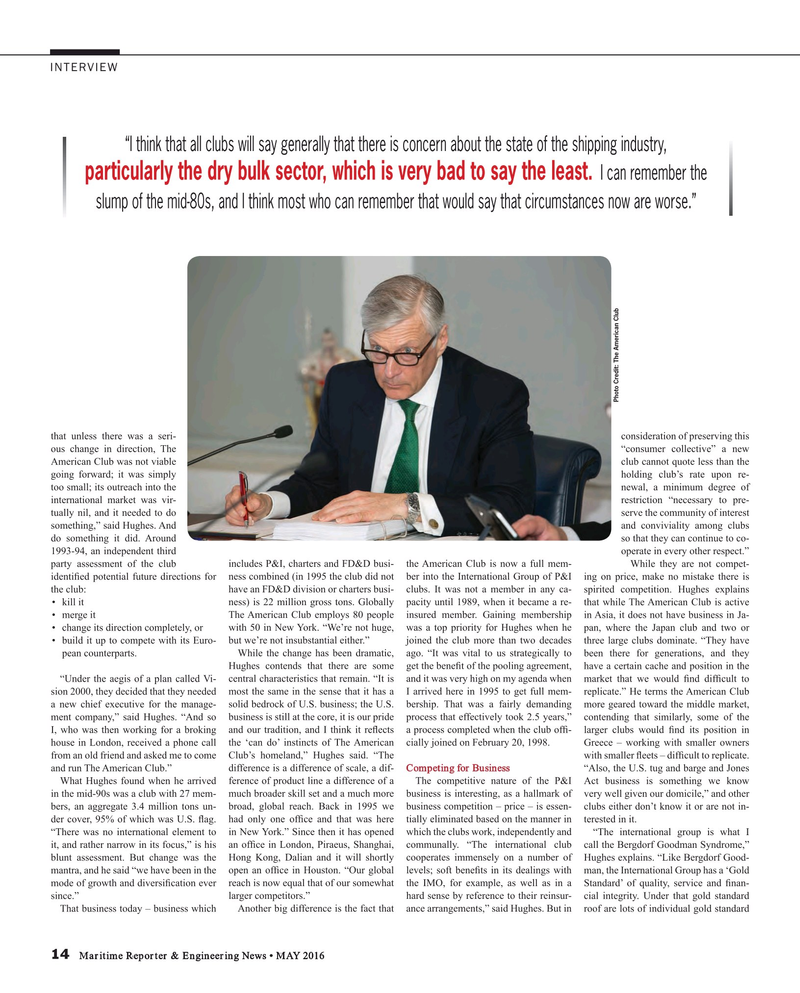
Page 14: of Maritime Reporter Magazine (May 2016)
The Marine Propulsion Edition
Read this page in Pdf, Flash or Html5 edition of May 2016 Maritime Reporter Magazine
INTERVIEW “I think that all clubs will say generally that there is concern about the state of the shipping industry, particularly the dry bulk sector, which is very bad to say the least. I can remember the slump of the mid-80s, and I think most who can remember that would say that circumstances now are worse.”
Photo Credit: The American Club that unless there was a seri- consideration of preserving this ous change in direction, The “consumer collective” a new
American Club was not viable club cannot quote less than the going forward; it was simply holding club’s rate upon re- too small; its outreach into the newal, a minimum degree of international market was vir- restriction “necessary to pre- tually nil, and it needed to do serve the community of interest something,” said Hughes. And and conviviality among clubs do something it did. Around so that they can continue to co- 1993-94, an independent third operate in every other respect.” party assessment of the club includes P&I, charters and FD&D busi- the American Club is now a full mem- While they are not compet- identi? ed potential future directions for ness combined (in 1995 the club did not ber into the International Group of P&I ing on price, make no mistake there is the club: have an FD&D division or charters busi- clubs. It was not a member in any ca- spirited competition. Hughes explains • kill it ness) is 22 million gross tons. Globally pacity until 1989, when it became a re- that while The American Club is active • merge it The American Club employs 80 people insured member. Gaining membership in Asia, it does not have business in Ja- • change its direction completely, or with 50 in New York. “We’re not huge, was a top priority for Hughes when he pan, where the Japan club and two or • build it up to compete with its Euro- but we’re not insubstantial either.” joined the club more than two decades three large clubs dominate. “They have pean counterparts. While the change has been dramatic, ago. “It was vital to us strategically to been there for generations, and they
Hughes contends that there are some get the bene? t of the pooling agreement, have a certain cache and position in the “Under the aegis of a plan called Vi- central characteristics that remain. “It is and it was very high on my agenda when market that we would ? nd dif? cult to sion 2000, they decided that they needed most the same in the sense that it has a I arrived here in 1995 to get full mem- replicate.” He terms the American Club a new chief executive for the manage- solid bedrock of U.S. business; the U.S. bership. That was a fairly demanding more geared toward the middle market, ment company,” said Hughes. “And so business is still at the core, it is our pride process that effectively took 2.5 years,” contending that similarly, some of the
I, who was then working for a broking and our tradition, and I think it re? ects a process completed when the club of? - larger clubs would ? nd its position in house in London, received a phone call the ‘can do’ instincts of The American cially joined on February 20, 1998. Greece – working with smaller owners from an old friend and asked me to come Club’s homeland,” Hughes said. “The with smaller ? eets – dif? cult to replicate. and run The American Club.” difference is a difference of scale, a dif- Competing for Business “Also, the U.S. tug and barge and Jones
What Hughes found when he arrived ference of product line a difference of a The competitive nature of the P&I Act business is something we know in the mid-90s was a club with 27 mem- much broader skill set and a much more business is interesting, as a hallmark of very well given our domicile,” and other bers, an aggregate 3.4 million tons un- broad, global reach. Back in 1995 we business competition – price – is essen- clubs either don’t know it or are not in- der cover, 95% of which was U.S. ? ag. had only one of? ce and that was here tially eliminated based on the manner in terested in it.
“There was no international element to in New York.” Since then it has opened which the clubs work, independently and “The international group is what I it, and rather narrow in its focus,” is his an of? ce in London, Piraeus, Shanghai, communally. “The international club call the Bergdorf Goodman Syndrome,” blunt assessment. But change was the Hong Kong, Dalian and it will shortly cooperates immensely on a number of Hughes explains. “Like Bergdorf Good- mantra, and he said “we have been in the open an of? ce in Houston. “Our global levels; soft bene? ts in its dealings with man, the International Group has a ‘Gold mode of growth and diversi? cation ever reach is now equal that of our somewhat the IMO, for example, as well as in a Standard’ of quality, service and ? nan- since.” larger competitors.” hard sense by reference to their reinsur- cial integrity. Under that gold standard
That business today – business which Another big difference is the fact that ance arrangements,” said Hughes. But in roof are lots of individual gold standard 14 Maritime Reporter & Engineering News • MAY 2016
MR #5 (10-17).indd 14 MR #5 (10-17).indd 14 4/29/2016 3:34:24 PM4/29/2016 3:34:24 PM

 13
13

 15
15
